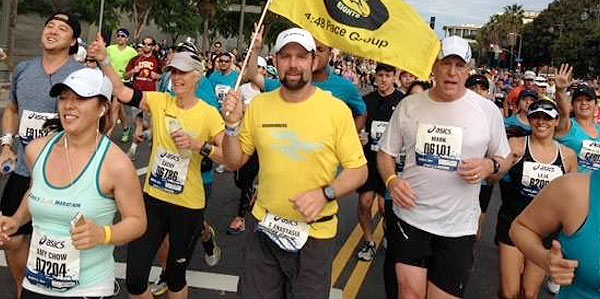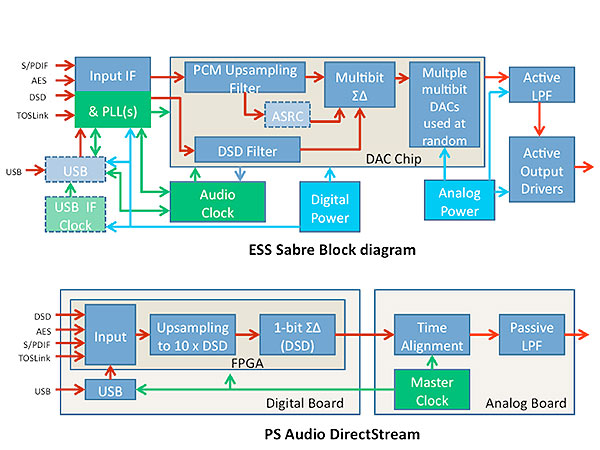Simplicity is Overrated.
Is simplicity as it applies to audio production and equipment design the ultimate expression of fidelity. Is a straight wire from the microphone to the amplifier and speaker going to produce the “best” sound? How about the architecture of a digital to analog converter? Do those that claim the inherent simplicity of a “1-bit” DSD converter have it right (even if the reality inside is a multibit system)? If there are fewer components or chips in the layout of circuit, can you count on better sound? Let’s think about it.
Yesterday I ran (and walked) the LA Marathon. It was my fifth 26.2 mile event. While a large part of the U.S. has been digging out from the results of the “polar vortex”, the weather in Southern California has been balmy. The temperature was in the 80’s yesterday with a bright blue sky. My race suffered as a result…it was just too hot for me. I crossed the finish line…but in my worst time ever! Despite having trained for six months and run over 100 miles a month, I struggled.
But you look at the video of the elite men and women athletes (I never see them from the middle of the pack!); they sailed from Dodger Stadium to Santa Monica in just over 2 hours. They make it look so simple. For two hours plus, they put one foot in front of the other just like I did. But they do it 180 times per minute and keep a pace of less than 5 minutes per mile…it’s a feat that is beyond my ability to comprehend. And although it may seem effortless and natural as you view them during a race, it’s the furthest thing from simple to become a world-class athlete.
As inspiration the other evening, I watched documentary on Usain Bolt, the Jamaican sprinter that has won multiple gold medals and established the world records at 100 and 200 meters. This guy’s has been described as a “natural runner”. In the documentary, he let the interviewer know that there was nothing natural or easy about running up near 28 miles per hour. It’s the result of a very complex training regime, hundreds of circuits of the track, days of weight training and a carefully crafted program laid out by a good coach.
What we experience is the 9.58 seconds when Usain springs from the starting blocks and sails down the track to the finish line. We don’t see the thousands of hours that went into making him the fastest man the ever lived. The same goes with the winners of yesterday’s marathon. They run thousands of miles to get ready for their races! I’m humbled by their dedication and success. I need to up my game both mentally and physically if I’m going to get from the start to the finish in less than 5 hours (that’s my goal…and I’m gotten close with a PR of 5:10).
Figure 1 – A block diagram of the ESS Sabre high-end PCM DAC and the block diagram of the new architecture from PS Audio in their DirectStream DAC.
Simplicity is overrated. Even a straight microphone to a recorder and then back through a speaker is a VERY complex operation. Just the microphone itself is a marvel of engineering. Don’t let anyone show you a block diagram with less boxes in it and make the claim that it MUST be better sounding because it’s “simple”. It might be that the most complex machine does a better job when it comes to dynamic range or frequency response. I believe this is the case with PCM…you get natural, pure, accurate and clear sound. And that’s what I want.
I happened upon a video of a quad copter (you know, those four bladed, computer controlled flying machines) keeping a long stick upright as it flew around a room. What a person can do with a broomstick on the end of your hand with some practice, this copter was doing on its own. Amazing! It seemed so simple to watch. But the complex computer commands, the variable speed motors, the sensors necessary to accomplish that “visible simplicity” are almost beyond my ability to fathom it.
Simplicity is not the goal. And it’s not necessarily the best path to the goal. The realization of the goal by the best and most effective method is all that counts. PCM does that better than any other audio encoding format…without exception.



This is in response to two earlier columns by Dr. Aix: (1) I just listened again to the Zenph remaster of Rachmaninov solo piano. This is a remarkable recording by one of the greatest pianists who ever lived. Does anyone know what has happened with Zenph and if their technology might be used again? There are so many historical recordings that could benefit from this approach; (2) I agree with Dr. Aix that redbook has been unduly trashed by some commentators. I have become convinced that the quality of the work putting together the initial recording is so key to the end result. The limitations of the resolution are there, but the variance in recording and mastering I think often exceeds the limitations of the format. I have some terrific CDs. Yes, a terrific disc of higher resolution can sound better, but the format alone won’t do it. (3) In this regard…anyone hear the “fresh” Reference Recording series? Their R. Strauss SACD disc in 5.1 is pretty special, and shows what can be done with both resolution and recording quality going for you.
Zenph is still around although they are not doing re-performances any longer. They have focused on accompaniment software for educational purposes from what I know.
Redbook can deliver terrific sound. I got this note from John Siau of Benchmark:
“I fully agree that the CD format is an excellent distribution format. Noise-shaped dither can extend the apparent dynamic range at least 12 dB, so we are not even limited to 96 dB. Anyone who doubts the effectiveness of noise-shaping should look at DSD. The 1-bit DSD format proves that noise shaping works!
Obviously the 16-bit format falls short in production applications. Longer word lengths (24-bit, 32-bits, or 64-bits) are now used in the studio to allow many cascaded and summed DSP operations without loss of SNR. Early DAW systems were limited to 16-bit storage, and were notorious for producing poor results. All newer DAWs are high-resolution systems and it is now possible to produce outstanding CDs if the conversion to 44.1/16 is the last step in the mastering process. Few recordings fully exploit the capabilities of the CD. Obviously there are some high-resolution recordings (such as those produced by AIX) that exceed the capabilities of the CD.
Nevertheless, it is still difficult to configure a playback system that is significantly better that CD-quality. Benchmark is addressing this issue with the new AHB2 high-resolution power amplifier. The AHB2 has a bandwidth that exceeds 200 kHz, and a SNR that approaches 130 dB.“